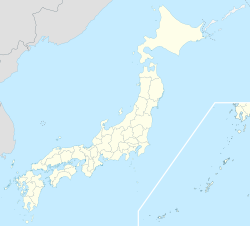大津市
|
Ōtsu 大津市 |
|||
|---|---|---|---|
| Core city | |||
| Ōtsu City | |||

|
|||
|
|||
 Location of Ōtsu in Shiga Prefecture |
|||
| Location in Japan | |||
| Coordinates: 35°1′N 135°51′E / 35.017°N 135.850°ECoordinates: 35°1′N 135°51′E / 35.017°N 135.850°E | |||
| Country | Japan | ||
| Region | Kansai | ||
| Prefecture | Shiga Prefecture | ||
| Government | |||
| • Mayor | Naomi Koshi | ||
| Area | |||
| • Total | 464.51 km2 (179.35 sq mi) | ||
| Population (October 1, 2016) | |||
| • Total | 341,314 | ||
| • Density | 730/km2 (1,900/sq mi) | ||
| Symbols | |||
| • Tree | Prunus serrulata | ||
| • Flower | Viola eizanensis | ||
| • Bird | Black-headed gull | ||
| Time zone | Japan Standard Time (UTC+9) | ||
| City hall address | 3-1 Goryō-chō, Ōtsu-shi, Shiga-ken 520-8575 |
||
| Website | www |
||
Ōtsu (大津市 Ōtsu-shi) is the capital city of Shiga Prefecture, Japan. Ōtsu is known as the main port of Lake Biwa, the largest lake in Japan. It briefly served as the capital of Japan from 667 to 672 AD during the Asuka period (538 – 710). The city is home to numerous sites of historical importance, notably the temples of Mii-dera, Ishiyama-dera, and Enryaku-ji and the Hiyoshi Taisha shrine. Enryaku-ji is part of the UNESCO World Heritage Site "Historic Monuments of Ancient Kyoto (Kyoto, Uji and Otsu Cities)". Ōtsu was incorporated as a city on October 1, 1898.
As of October 1, 2016, the city has an estimated population of 341,314 and a population density of 730 persons per km2. The total area is 464.51 km2 (179 sq mi).
Ōtsu, meaning "big port", was a center of inland water transportation since ancient times. The city was an important port on Lake Biwa, and a center of trade by water and land to other areas of Japan. Ōtsu was part of Ōmi Province, an old province of Japan until the modern period. The port is referred to in the Man'yōshū as Shiga no Ōwada (志賀の大わだ) and Shigatsu (志賀津). In the years 667 to 672, the Ōmi Ōtsu Palace was founded by Emperor Tenji (626-672). The Jinshin War devastated the Ōmi Ōtsu Palace, and Ōtsu was renamed Furutsu (古津, "old port"). A new capital, Heian-kyō, (now Kyoto), was established in the immediate neighborhood in 794, and Ōtsu was revived as an important traffic point and satellite town of the capital. With the establishment of the new capital, the name of the city was restored to "Ōtsu".
...
Wikipedia



